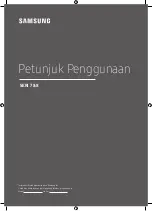
Service Modes, Error Codes, and Fault Finding
5.
How to Navigate
Use one of the following methods:
•
When you press the MENU button on the remote control,
the set will switch on the normal user menu in the SDM
mode.
•
On the TV, press and hold the VOLUME DOWN and press
the CHANNEL DOWN for a few seconds, to switch from
SDM to SAM and reverse.
How to Exit
Switch the set to STANDBY by pressing the mains button on
the remote control transmitter or the television set.
If you turn the television set off by removing the mains (i.e.,
unplugging the television) without using the mains button, the
television set will remain in SDM when mains is re-applied, and
the error buffer is not cleared.
5.2.2
Service Alignment Mode (SAM)
Purpose
•
To change option settings.
•
To display / clear the error code buffer.
•
To perform alignments.
Specifications
•
Operation hours counter (maximum five digits displayed).
•
Software version, Error codes, and Option settings display.
•
Error buffer clearing.
•
Option settings.
•
AKB switching.
•
Software alignments (Tuner, White Tone, Geometry &
Audio).
•
NVM Editor.
•
ComPair Mode switching.
How to Enter
To enter SAM, use one of the following methods:
•
Press the following key sequence on the remote control
transmitter: “
062596
" directly followed by the OSD/
STATUS/INFO(I+) button (do not allow the display to time
out between entries while keying the sequence).
•
Or via ComPair.
After entering SAM, the following screen is visible, with SAM in
the upper right corner of the screen to indicate that the
television is in Service Alignment Mode.
Figure 5-3 SAM menu
Menu Explanation
1.
LLLLL.
This represents the run timer. The run timer counts
normal operation hours, but does not count standby hours.
2.
AAABCD-X.Y.
This is the software identification of the
main microprocessor:
–
A
= the project name (LC04.x).
–
B
= the region: E= Europe, A= Asia Pacific, U= NAFTA,
L= LATAM.
–
C
= the software diversity:
•
Europe:
T= 1 page TXT, F= Full TXT, V= Voice
control.
•
LATAM and NAFTA:
N= Stereo non-dBx, S=
Stereo dBx.
•
Asian Pacific:
T= TXT, N= non-TXT, C= NTSC.
•
ALL regions:
M= mono, D= DVD, Q= Mk2.
–
D
= the language cluster number.
–
X
= the main software version number (updated with a
major change that is incompatible with previous
versions).
–
Y
= the sub software version number (updated with a
minor change that is compatible with previous
versions).
3.
EEEEE-F.GG.
This is the software identification of the
Scaler:
–
EEEEEE
= the scaler sw cluster
–
F
= the main sw version no.
–
GG
= the sub-version no.
4.
SAM.
Indication of the Service Alignment Mode.
5.
Error Buffer.
Shows all errors detected since the last time
the buffer was erased. Five errors possible.
6.
Option Bytes.
Used to set the option bytes. See “Options”
in the Alignments section for a detailed description. Seven
codes are possible.
7.
Clear.
Erases the contents of the error buffer. Select the
CLEAR menu item and press the MENU RIGHT key. The
content of the error buffer is cleared.
8.
Options.
Used to set the option bits. See “Options” in the
Alignments section for a detailed description.
9.
Tuner.
Used to align the tuner. See “Tuner” in the
Alignments section for a detailed description.
10.
White Tone.
Used to align the white tone. See “White
Tone” in the Alignments section for a detailed description.
11.
Audio.
No audio alignment is necessary for this television
set.
12.
NVM Editor.
Can be used to change the NVM data in the
television set. See table “NVM data” further on.
13.
SC NVM Editor.
Can be used to edit Scaler NVM.
14.
ComPaIr.
Can be used to switch on the television to In
System Programming (ISP) mode, for software uploading
via ComPair.
Caution:
When this mode is selected without ComPair
connected, the TV will be blocked. Remove the AC power
to reset the TV.
How to Navigate
•
In SAM, select menu items with the MENU UP/DOWN keys
on the remote control transmitter. The selected item will be
highlighted. When not all menu items fit on the screen, use
the MENU UP/DOWN keys to display the next / previous
menu items.
•
With the MENU LEFT/RIGHT keys, it is possible to:
–
Activate the selected menu item.
–
Change the value of the selected menu item.
–
Activate the selected submenu.
•
In SAM, when you press the MENU button twice, the set
will switch to the normal user menus (with the SAM mode
still active in the background). To return to the SAM menu
press the MENU or STATUS/EXIT button.
•
When you press the MENU key in while in a submenu, you
will return to the previous menu.
F_15420_030.eps
060605
00035 LC4XEP1 1.15/S4XPVX 1.23 SAM
ERR 0 0 0 0 0
OP 000 057 140 032 120 128 000
. Clear Clear ?
. Options
. Tuner
. White Tone
. Audio
. NVM Editor
. SC NVM Editor
. ComPair Mode On
www.freeservicemanuals.info
















































